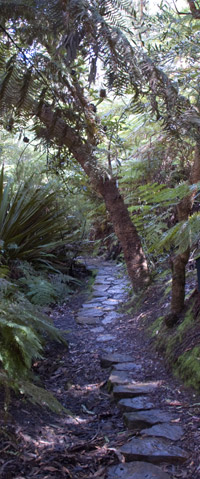Horticulture - Soils
The Botanic Gardens is located on the eastern foothills of Black Mountain. The soils of the Gardens are low in fertility, rocky and dominated by clay loams and heavily packed clays. The soil pH is around 6 to 6.5.
The soils vary down the slope:
- High – shallow poor soils with rocky outcrops
- Mid – overlay of silt brought in from Lake Burley Griffin
- Low – heavy poorly drained clays
Silt from the excavation of Lake Burley Griffin was added as a top layer to the Eucalypt Lawn and terraces. Unfortunately, this top layer is almost impenetrable to water and occasionally wetting agents are applied to try to address this problem.
In some beds, the soil is removed and replaced with a different mix. This is to improve the drainage and to provide the sort of soil found in the plants' natural habitat.
- The Western Mallee (section 100) had its soil excavated to a depth of 1 – 3 metres and was replaced with a mixture of sand and potting mix.
- When established the Rock Garden had some blue metal mix incorporated with the soil to raise the pH. Over the years, the metal mix has washed away.
- In recent years the Rock Garden has been topped up with a granite mix: granite, sand and clay, or a sand mix: sand and decomposed pine bark. Different soil mixtures are used in the subsections of the Rock Garden to allow for plants from alpine to semi-arid habitats to thrive.
- The addition of large rocks in the Rock Garden allows for temperature buffering in the beds. The rocks absorb heat during the day and radiate warmth at night, allowing plants that are frost sensitive to be grown.
- Recycled sandstone and rubble from the Sydney cross-city tunnel replaced the soil of the Eastern Australia sandstone flora bed.
Much of the higher slopes of the Gardens are naturally regenerating bushland.
There is no additional fertiliser applied to plants on a regular basis. The only organic material added to the soils is a top layer of mulch.
![Director of National Parks [logo]](../../../images/dnp_90px.gif)






